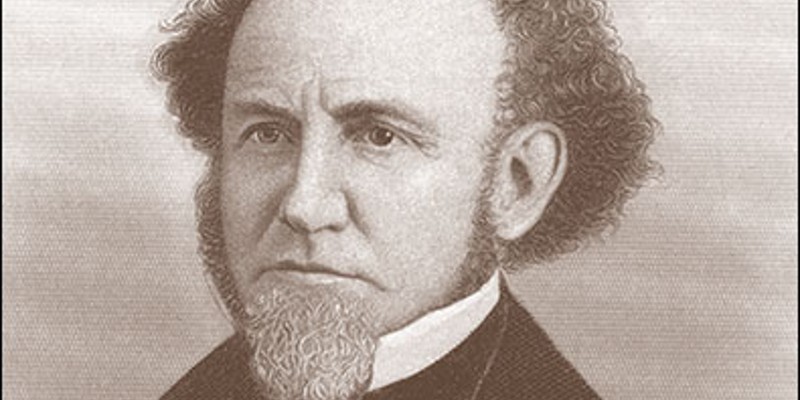Sometimes greatness can sneak between cracks, but to the eye of legendary University of Illinois Geology Professor, George White (1903-1985), a great geologist was bound get his or her due. As a prolific collector of Americana and a man with a passion for the history of geology (he established the History of Geology course at the University of Illinois), Charles Whittlesey would not and did escape his research eye.
Finally, from Stanley M. Totten, a 1962 University of Illinois graduate, who rightly claims George White as his graduate advisor and mentor, Whittlesey has received the biographical treatment he deserves. The Brilliance of Charles Whittlesey is the first full length biography of this extraordinary man who accomplished and published so much, but about whom we knew so little.
This multi-decade pursuit began when Professor White, in poor health, asked Stanley Totten to help him prepare a manuscript on Charles Whittlesey (1808-1886) for the Geological Society of America in 1985. That project drew Totten into the life and importance of Whittlesey. After retirement from a 40 year distinguished teaching career in the Department of Geology at Hanover College in Indiana, Totten had the time to pursue this subject in depth. That he certainly did.
Using microfilm from the National Archives, and the extensive Whittlesey archives at the Western Reserve Historical Society, an organization Whittlesey was instrumental in founding and guiding, Totten has unearthed a treasure trove of information on a man whose career and contributions have largely been relegated to bibliography entires and footnotes. Whittlesey left a large collection of personal notes, maps, and monographs that Totten has used and quoted for the information in this book. But, with so extensive a paper trail, why is so little known about him I asked Totten?
Totten explained, “First all, Whittlesey’s handwriting is almost impossible to read and much of his archival material on paper is deteriorating. I had to have large quantities of paper material transferred to microfilm and then learn to read his handwriting. There were times as well, he just did not have time or energy to fight those who so casually borrowed his material.”
The other side of Whittlesey’s neglect is his world of constant on-site research and travel that took him into wilderness areas leaving the door open for others to use his work with little or no attribution, and that frequently happened. Totten makes a great case that others simply received credit for his research. So, what did this life of research, exploring and working accomplish?
A lot — starting with geology, he mapped coal beds in the midwest, copper beds in Michigan’s Upper Peninsula, iron ore beds on Michigan’s Upper Peninsula, Wisconsin, and Minnesota, and evaluated their economic potential. This would lead later to mineral booms of significant economic magnitude from such formations as the Penokie and Mesabi Iron Ore ranges and the huge copper deposits of Michigan’s Upper Peninsula. He also wrote extensively on glacial geology and championed now accepted theories of Continental Glaciation, lowered sea level as result of that glaciation and glacial drift as stratigraphic units to note some of his accurate research on that subject.
Whittlesey’s interests and skills encompassed archaeology. His West Point background made him aware of earthworks and he carefully described and diagramed many of Ohio’s prehistoric earthwork complexes at Newark, Marietta, and other Ohio locations. He accurately dated these structures to be about 2,000 years old, proved the earthworks of Southern Ohio were not defensive “forts”, and promoted the theory that the copper from Michigan’s Upper Peninsula found in the Ohio earthworks was not the result of a trade network but a seasonal mining routine of these prehistoric societies. A good deal of his research was used by Squier and Davis in their famous 1848 monograph, “Ancient Monuments of the Mississippi Valley”, publication number one of the Smithsonian.
Whittlesey’s extensive work in this publication is frequently altered and relegated to footnotes and bibliographic entries, yet, he provided much of the information that appears in this legendary publication on Ohio. His complaints did little to correct his status in that publication. With an interest in prehistory, it seems logical he would have an interest in history and he did. He wrote on Native American cultures he observed, Ohio and midwestern history, and helped to establish the Western Reserve Historical Society, even serving as its president for 19 years and building its archives.
Then in 1861-62, he made history. Enlisting in the 20th Ohio Regiment, he used his West Point background to design the defenses of Cincinnati, which were never breached. He then led patrols that controlled Secessionists’ attempts to turn northern Kentucky. In November of 1961, he suggested to Commanding General Halleck, the campaign outline to capture Forts Henry and Donelson, then campaigned with that plan and commanded a unit at Shiloh. Leaving the US Army after Shiloh with medical issues, he could say he had recorded history and made history. He would continue field work and publishing until chronic ill health confined him to this home in Cleveland, but at his death in 1886, he left behind just over 200 publications.
Stanley Totten’s readable and fact-packed book from original sources is an excellent tribute to a man who previously has barely surfaced in the history of the Midwest, despite his enormous contributions to our area and nation. The only flaw in the book is some less than diligent editing by the Kent State University Press that left off numbers on dates and got a major name misspelled. The dedication of a University of Illinois professor who was passionate about the history of geology who passed the torch on the contributions of Charles Whittlesey to one of his outstanding students is a classic story of the inspiring teacher and student. But, the really good news is Stanley Totten never forgot the inspiration he received from George White and his diligence has produced a long overdue study.
Top image from Kent University Press website.








